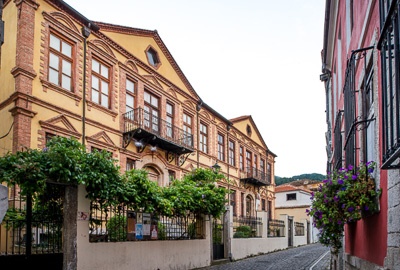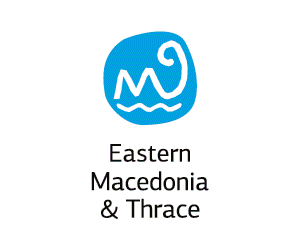
From Xanthi
set off for Pomakohoria and Thermes. You cross a unique
landscape, verdant, with traditional settlements and tobacco
crops. You encounter Sminthi, Miki, Ehino in succession and arrive
at Thermes in just over an hour, having driven 44.15km.
The Relief of Mithras Tauroctonos The Relief
of Mithras Tauroctonos (Mithras the Bull-slayer), dating to
2nd - early 3rd century AD, was chiseled out of a large rock, near
Thermes Village in Xanthi and depicts Mithras (God of the Sun, of
Persian origin) sacrificing a bull in the centre within a relief
frame, which symbolizes a cave. To the right and left are the God’s
disciples, Kautis and kautopatis. The
archaeological site is open to visitors.
For more information, contact LA’ EPKA Telephone:
+30 25410 51003, +30 25410
51783
Xanthi Xanthi is a
Byzantine city and believed to be
guarded by the angels as testified by the
“place’s marks”, according to
historian Dimitris Mavridis. The monasteries
of Pammegiston Taxiarxon,
Panagia Arhongeliotissa, Panagia Kalamus and Agios Giorgios
Monastery (according to recent research, there is a church of the same
name there today) are situated at the four corners of the
horizon, as if by analogy to the four tips of a cross, “crossing” the area
and perpetuating the town’s existence. Xanthi is
one of the few towns in Greece
which has developed harmoniously , with
respect and consideration for its
history and past. A multicultural town, it
has managed to gain a place in
the heart of all its inhabitants, regardless
of religion or ethnic origin. The Old
Town of Xanthi “At that
time, a copy of the belle epoch co-existed with authentic Turkish
Minarets, and this gave colour and content to a very diverse population
consisting of people from from all corners of Greece, who had
accidentally ended up in the border area and could be seen
dancing the Charleston in public squares” Manos
Hadjidakis The Old
Town of Xanthi is located in the northern part of the town and
constitutes its historic nucleus. It covers an area of 380,000m2. The town
was built after 1829, the year great earthquakes completely destroyed
the previous settlement. The town was built on the ruins
and around churches which had probably been there since
Byzantine ‘Xantheia’. During the
19th century, Xanthi was a small town of 8,000 residents, financially
prosperous, thanks to wealth from the cultivation, processing
and transportation of tobacco and its products, but also
because of its privileged position on significant trade routes. The town
was built by Epirote and Macedonian craftsmen. It is characterized
by its winding cobbled streets and filled with simple Balkan
houses, inns, shops, churches, characteristic of the last Ottoman
period, but also western neoclassical mansions whose owners were
mainly tobacco merchants. In the old town there are 1,200
listed buildings. Of these, 140 are considered highly remarkable, 130
remarkable 260 of special interest. Mansions such as the one
belonging to the tobacco merchant Kougioumtzoglou, which is home to
the town’s Folk Museum, or Orfanidis’ mansion, today the
Municipal Building. The old garrison headquarters where the great
musical composer, Manos Hadjidakis, spent the first years of his
life, has been preserved and is home to the “Manos Hadjidakis” multiplex
of Art and Thought. The Municipal Picture Gallery of Xanthi
“Chr. Pavlidis” is an excellent example of traditional West- Macedonian-Epirote
architecture with its wooden ceilings being the chief
feature, unique in the region and Tobacco Warehouse P at 9,
Kapnergates Street, which belongs to the Foundation of Thracian
Art and Tradition.
 From Xanthi
set off for Pomakohoria and Thermes. You cross a unique
landscape, verdant, with traditional settlements and tobacco
crops. You encounter Sminthi, Miki, Ehino in succession and arrive
at Thermes in just over an hour, having driven 44.15km. The Relief of Mithras Tauroctonos The Relief
of Mithras Tauroctonos (Mithras the Bull-slayer), dating to
2nd - early 3rd century AD, was chiseled out of a large rock, near
Thermes Village in Xanthi and depicts Mithras (God of the Sun, of
Persian origin) sacrificing a bull in the centre within a relief
frame, which symbolizes a cave. To the right and left are the God’s
disciples, Kautis and kautopatis. The
archaeological site is open to visitors.
For more information, contact LA’ EPKA Telephone:
+30 25410 51003, +30 25410
51783 Xanthi Xanthi is a
Byzantine city and believed to be
guarded by the angels as testified by the
“place’s marks”, according to
historian Dimitris Mavridis. The monasteries
of Pammegiston Taxiarxon,
Panagia Arhongeliotissa, Panagia Kalamus and Agios Giorgios
Monastery (according to recent research, there is a church of the same
name there today) are situated at the four corners of the
horizon, as if by analogy to the four tips of a cross, “crossing” the area
and perpetuating the town’s existence. Xanthi is
one of the few towns in Greece
which has developed harmoniously , with
respect and consideration for its
history and past. A multicultural town, it
has managed to gain a place in
the heart of all its inhabitants, regardless
of religion or ethnic origin. The Old
Town of Xanthi “At that
time, a copy of the belle epoch co-existed with authentic Turkish
Minarets, and this gave colour and content to a very diverse population
consisting of people from from all corners of Greece, who had
accidentally ended up in the border area and could be seen
dancing the Charleston in public squares” Manos
Hadjidakis The Old
Town of Xanthi is located in the northern part of the town and
constitutes its historic nucleus. It covers an area of 380,000m2. The town
was built after 1829, the year great earthquakes completely destroyed
the previous settlement. The town was built on the ruins
and around churches which had probably been there since
Byzantine ‘Xantheia’. During the
19th century, Xanthi was a small town of 8,000 residents, financially
prosperous, thanks to wealth from the cultivation, processing
and transportation of tobacco and its products, but also
because of its privileged position on significant trade routes. The town
was built by Epirote and Macedonian craftsmen. It is characterized
by its winding cobbled streets and filled with simple Balkan
houses, inns, shops, churches, characteristic of the last Ottoman
period, but also western neoclassical mansions whose owners were
mainly tobacco merchants. In the old town there are 1,200
listed buildings. Of these, 140 are considered highly remarkable, 130
remarkable 260 of special interest. Mansions such as the one
belonging to the tobacco merchant Kougioumtzoglou, which is home to
the town’s Folk Museum, or Orfanidis’ mansion, today the
Municipal Building. The old garrison headquarters where the great
musical composer, Manos Hadjidakis, spent the first years of his
life, has been preserved and is home to the “Manos Hadjidakis” multiplex
of Art and Thought. The Municipal Picture Gallery of Xanthi
“Chr. Pavlidis” is an excellent example of traditional West- Macedonian-Epirote
architecture with its wooden ceilings being the chief
feature, unique in the region and Tobacco Warehouse P at 9,
Kapnergates Street, which belongs to the Foundation of Thracian
Art and Tradition.
From Xanthi
set off for Pomakohoria and Thermes. You cross a unique
landscape, verdant, with traditional settlements and tobacco
crops. You encounter Sminthi, Miki, Ehino in succession and arrive
at Thermes in just over an hour, having driven 44.15km. The Relief of Mithras Tauroctonos The Relief
of Mithras Tauroctonos (Mithras the Bull-slayer), dating to
2nd - early 3rd century AD, was chiseled out of a large rock, near
Thermes Village in Xanthi and depicts Mithras (God of the Sun, of
Persian origin) sacrificing a bull in the centre within a relief
frame, which symbolizes a cave. To the right and left are the God’s
disciples, Kautis and kautopatis. The
archaeological site is open to visitors.
For more information, contact LA’ EPKA Telephone:
+30 25410 51003, +30 25410
51783 Xanthi Xanthi is a
Byzantine city and believed to be
guarded by the angels as testified by the
“place’s marks”, according to
historian Dimitris Mavridis. The monasteries
of Pammegiston Taxiarxon,
Panagia Arhongeliotissa, Panagia Kalamus and Agios Giorgios
Monastery (according to recent research, there is a church of the same
name there today) are situated at the four corners of the
horizon, as if by analogy to the four tips of a cross, “crossing” the area
and perpetuating the town’s existence. Xanthi is
one of the few towns in Greece
which has developed harmoniously , with
respect and consideration for its
history and past. A multicultural town, it
has managed to gain a place in
the heart of all its inhabitants, regardless
of religion or ethnic origin. The Old
Town of Xanthi “At that
time, a copy of the belle epoch co-existed with authentic Turkish
Minarets, and this gave colour and content to a very diverse population
consisting of people from from all corners of Greece, who had
accidentally ended up in the border area and could be seen
dancing the Charleston in public squares” Manos
Hadjidakis The Old
Town of Xanthi is located in the northern part of the town and
constitutes its historic nucleus. It covers an area of 380,000m2. The town
was built after 1829, the year great earthquakes completely destroyed
the previous settlement. The town was built on the ruins
and around churches which had probably been there since
Byzantine ‘Xantheia’. During the
19th century, Xanthi was a small town of 8,000 residents, financially
prosperous, thanks to wealth from the cultivation, processing
and transportation of tobacco and its products, but also
because of its privileged position on significant trade routes. The town
was built by Epirote and Macedonian craftsmen. It is characterized
by its winding cobbled streets and filled with simple Balkan
houses, inns, shops, churches, characteristic of the last Ottoman
period, but also western neoclassical mansions whose owners were
mainly tobacco merchants. In the old town there are 1,200
listed buildings. Of these, 140 are considered highly remarkable, 130
remarkable 260 of special interest. Mansions such as the one
belonging to the tobacco merchant Kougioumtzoglou, which is home to
the town’s Folk Museum, or Orfanidis’ mansion, today the
Municipal Building. The old garrison headquarters where the great
musical composer, Manos Hadjidakis, spent the first years of his
life, has been preserved and is home to the “Manos Hadjidakis” multiplex
of Art and Thought. The Municipal Picture Gallery of Xanthi
“Chr. Pavlidis” is an excellent example of traditional West- Macedonian-Epirote
architecture with its wooden ceilings being the chief
feature, unique in the region and Tobacco Warehouse P at 9,
Kapnergates Street, which belongs to the Foundation of Thracian
Art and Tradition.





